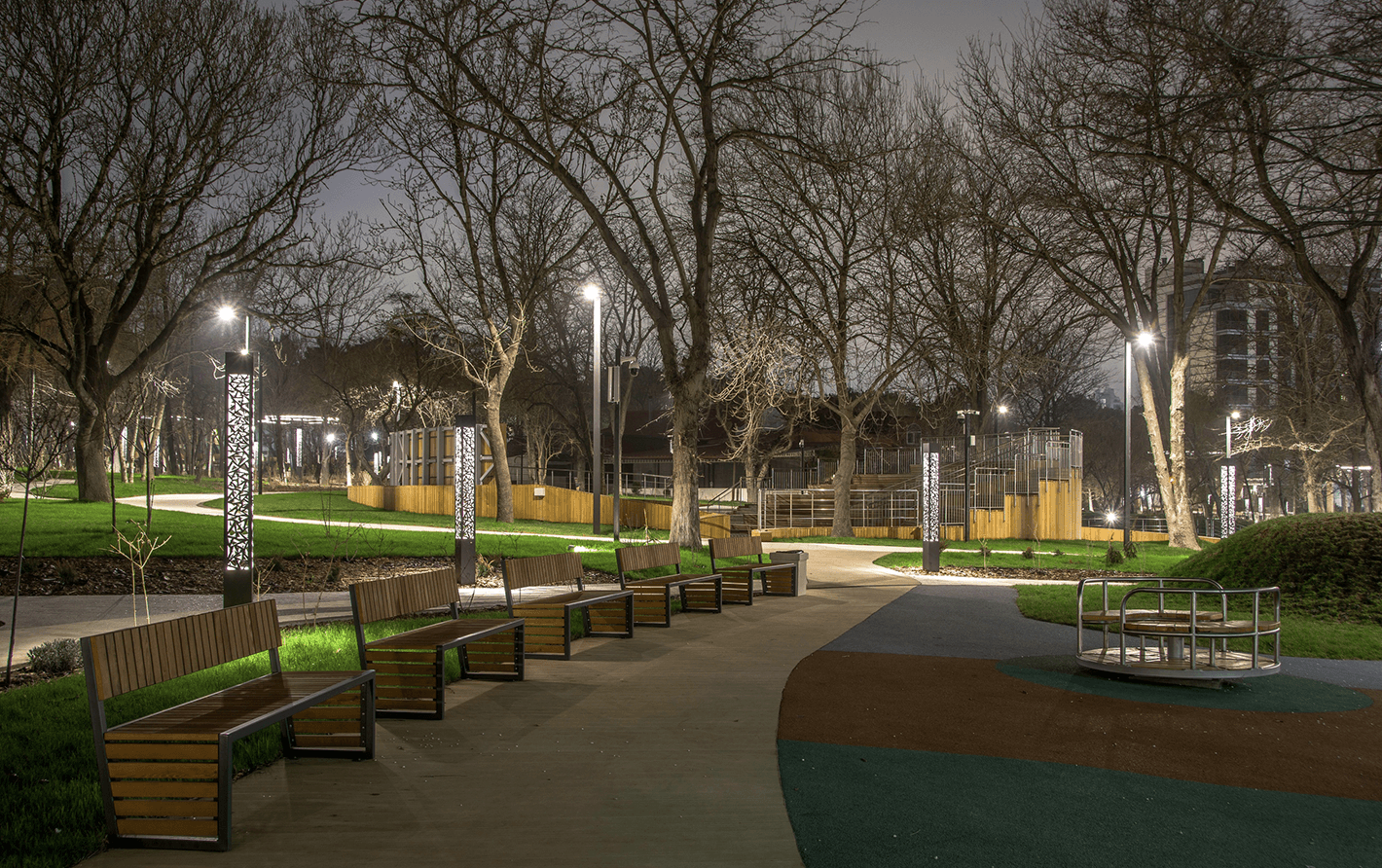lighting of parks and urban recreation areas

features of the lighting system
The park should be comfortable and safe throughout all seasons, in any weather, in daylight and at night. Artificial lighting in the park should contribute to the implementation of its functional purpose, and on the other hand, to preserve the biosphere: with plants, insects, small animals, birds in the urban environment. Thus, the lighting of a modern park should be biosphere-centric, unite the interests of people and preserve wildlife in the city.
Luminaires should be safe and easy to install and maintain. They must comply with outdoor performance, withstand temperature and humidity changes. Particular attention should be paid to protection against mechanical damage, which is most important in crowded places.
The choice of lighting solution should take into account not only the appearance of the park, but also the historical motif of the urban space. You need to choose lighting fixtures at the stage of the reconstruction project or the development of the design project of the recreation area. The use of decorative solutions "lamp + lighting pole" will add uniqueness to the project and will contribute to the recognition of your city.
Luminaires should be safe and easy to install and maintain. They must comply with outdoor performance, withstand temperature and humidity changes. Particular attention should be paid to protection against mechanical damage, which is most important in crowded places.
The choice of lighting solution should take into account not only the appearance of the park, but also the historical motif of the urban space. You need to choose lighting fixtures at the stage of the reconstruction project or the development of the design project of the recreation area. The use of decorative solutions "lamp + lighting pole" will add uniqueness to the project and will contribute to the recognition of your city.
rules for creating biosphere-centric lighting in parks
Lighting installations in the park should create light only in those places where it is necessary and was foreseen during the design. At the same time, outdoor lighting will enhance the feeling of security if its continuity, rhythm and uniformity are ensured in the park.
Lighting devices should visually harmonize with natural objects, park infrastructure, art objects and should be hardly noticeable in the daytime. Here we can highlight the emerging trend to replace lamps on high poles with bollards in parks. Such lamps set the volume of space, perform a navigation function in the park, focus on recreation areas and landscaping elements.
Luminaires should generate exactly as much light as it is provided in the lighting project. The overabundance of light that occurs in traditional design with a safety factor must be eliminated by automatic control of the luminous flux during the operation of the device. The light should spread to the right areas and, for example, illuminate the paths,
not tree crowns. Minimizing light pollution should become a mandatory component of projects, including limiting the spread of light to the upper hemisphere and “glare zones” as much as possible.
The use of presence sensors, photorelays, automatic controllers allows you to provide a given illumination of local areas or objects when it is necessary, for example, for pedestrians or cyclists. By applying dynamically changing "smart lighting", you control comfort, energy consumption and preserve the park ecosystem.
The spectral composition of light sources should contain a minimum amount of short-wave radiation (blue light). Lighting fixtures should have a low correlated color temperature (CCT). Perhaps the use of lighting solutions with dynamic changes in white shades, harmonized with changes in natural light. The use of additional reflective signs and indicators, special structures and technical devices for safe orientation and movement in parks will add an atmosphere of natural recreation to the city park.
Lighting devices should visually harmonize with natural objects, park infrastructure, art objects and should be hardly noticeable in the daytime. Here we can highlight the emerging trend to replace lamps on high poles with bollards in parks. Such lamps set the volume of space, perform a navigation function in the park, focus on recreation areas and landscaping elements.
Luminaires should generate exactly as much light as it is provided in the lighting project. The overabundance of light that occurs in traditional design with a safety factor must be eliminated by automatic control of the luminous flux during the operation of the device. The light should spread to the right areas and, for example, illuminate the paths,
not tree crowns. Minimizing light pollution should become a mandatory component of projects, including limiting the spread of light to the upper hemisphere and “glare zones” as much as possible.
The use of presence sensors, photorelays, automatic controllers allows you to provide a given illumination of local areas or objects when it is necessary, for example, for pedestrians or cyclists. By applying dynamically changing "smart lighting", you control comfort, energy consumption and preserve the park ecosystem.
The spectral composition of light sources should contain a minimum amount of short-wave radiation (blue light). Lighting fixtures should have a low correlated color temperature (CCT). Perhaps the use of lighting solutions with dynamic changes in white shades, harmonized with changes in natural light. The use of additional reflective signs and indicators, special structures and technical devices for safe orientation and movement in parks will add an atmosphere of natural recreation to the city park.
we will help you solve your problem